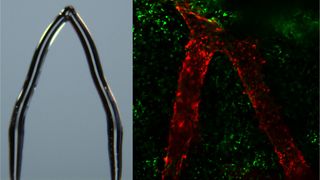
A 3D-printed ice template (left) was used a scaffolding to later grow cells (right) in a blood vessel-like structure.
(Image credit: Image courtesy of Feimo Yang.)
Scientists are working to build blood vessels from human cells using tiny ice sculptures — these frigid 3D forms twist and branch like real arteries and can be used as temporary scaffolds that later get melted away, to be replaced by living cells.
The researchers demonstrated the first step of this blood-vessel-building process in a recent study by creating the scaffolds using a 3D “ice printing” technique. The scaffolds were then coated in a gel that was embedded with human cells, which the team grew for about two weeks.
The ice printing technique could one day be used to make realistic, lab-grown blood vessels from human cells that capture the “complex geometries” of real vascular networks in the body, study researcher Feimo Yang, a doctoral candidate in mechanical engineering at Carnegie Mellon University, told Live Science.
“Currently, this is more of a proof of concept,” Yang said, but with development, this technique might be useful for fabricating blood vessels that could be transplanted into a person when they need an artery or vein repaired, replaced or bypassed.
Related: 3D-printed human brain tissue works like the real thing
Doctors currently harvest blood vessels for transplant from elsewhere in a patient’s body or from a donor. For some procedures, clinicians may use artificial blood vessels made from synthetic polymers; natural materials, such as proteins; or a mix of the two. However, these artificial blood vessels don’t perfectly replicate real ones and can fail, in part because they’re non-living.
That’s where ice printing could provide an advantage; it could help scientists create more realistic structures from real human cells.
Ice printing at tiny scales could also be helpful for crafting so-called organ-on-a-chip devices, Yang added. Such devices use fluids that flow through many tiny channels to sustain the growth of cells, and they act as miniature models of organs in the human body.
The team’s new work — which Yang will present at the 68th Biophysical Society Annual Meeting being held from Feb. 10 to 14 in Philadelphia — was built on the back of a printing technique called 3D-ICE, first described in a 2022 paper in the journal Advanced Science.
Our work on #ice #3Dprinting at the #microscale was featured in Additive Manufacturing! “almost like witnessing something magical…looks more like it belongs in a nature documentary” #CarnegieMellon #biomedical #microfluidics #AdditiveManufacturinghttps://t.co/j1u6qM3vLxJanuary 25, 2023
See more
The printer uses water as its “ink” and works by dripping drops of water onto a cold copper surface, which is kept at minus 31 degrees Fahrenheit (minus 35 degrees Celsius). When a water drop strikes the surface, it quickly freezes, and each successive drop adds to the growing ice sculpture.
The printer spits out about 200 drops of water per second, Yang said. This rate is slow enough to enable one water drop to start to freeze before the next one hits but fast enough that the drops still freeze together in a smooth structure, rather than creating defined layers. If the drops fell too fast, one liquid water drop would merge into the next and spread out before freezing, Yang explained.
The drops themselves are about 50 micrometers in diameter, so the resulting structures can be made with micron-level details. And the printing technique is fast. The sculptures the team made stood about 0.1 inch (3 millimeters) tall and 0.008 inch (0.2 mm) in diameter, and “it takes maybe 20 seconds” to print, Yang said.
Related: ‘Organ-on-chip’ shows how uterus coaxes embryo to implant in early pregnancy
There are other ice printing techniques that build small sculptures layer by layer or volume by volume, but these are not great at creating smooth surfaces. 3D-ICE, by contrast, can create smooth, free-flowing shapes closer to what one sees in the human circulatory system.
After creating a tiny sculpture with their ice printer, Yang and colleagues coated the structure in a gelatin-based material. Because their printer specifically uses “heavy water” — in which the hydrogen atoms are replaced by deuterium — the ice stays frozen at above-freezing temperatures. That meant the researchers could work at temperatures where their gel stayed malleable while the ice remained frozen.
Using ultraviolet light, they melted the ice away and hardened the gel, leaving smooth channels that closely resemble blood vessels. The team then added cells that line blood vessels, called endothelial cells, to the gel and showed that they could grow the cells for two weeks. In the future, they’ll experiment with growing the cells for longer.
While it will be some time before 3D-ICE could be used to craft blood vessels destined for a human patient’s body, “hopefully, we’ll be able to expand the use of this technology,” Yang said.
Ever wonder why some people build muscle more easily than others or why freckles come out in the sun? Send us your questions about how the human body works to community@livescience.com with the subject line “Health Desk Q,” and you may see your question answered on the website!
Get the world’s most fascinating discoveries delivered straight to your inbox.
Nicoletta Lanese is the health channel editor at Live Science and was previously a news editor and staff writer at the site. She holds a graduate certificate in science communication from UC Santa Cruz and degrees in neuroscience and dance from the University of Florida. Her work has appeared in The Scientist, Science News, the Mercury News, Mongabay and Stanford Medicine Magazine, among other outlets. Based in NYC, she also remains heavily involved in dance and performs in local choreographers’ work.
>>> Read full article>>>
Copyright for syndicated content belongs to the linked Source : Live Science – https://www.livescience.com/health/heart-circulation/ice-printing-tiny-sculptures-could-help-scientists-engineer-blood-vessels
